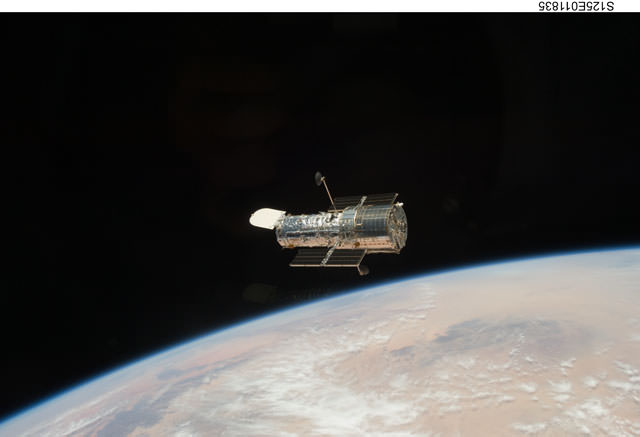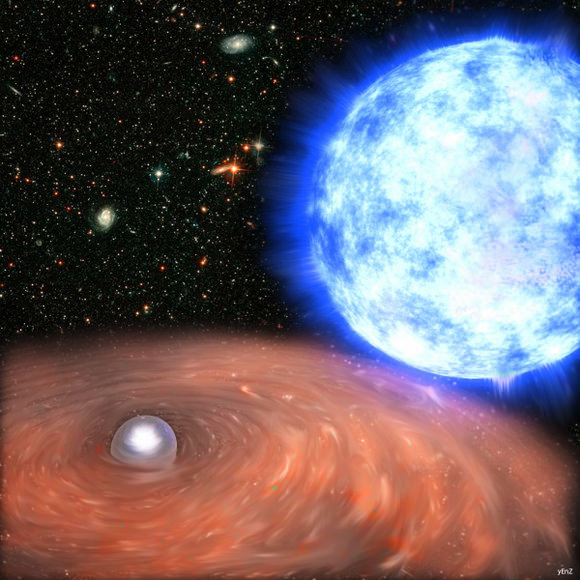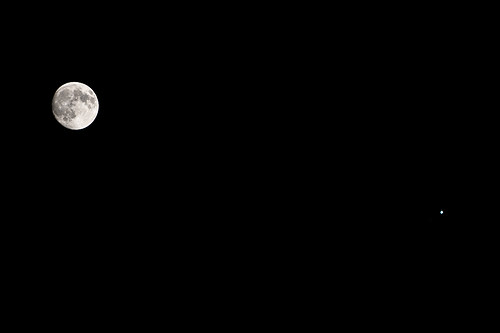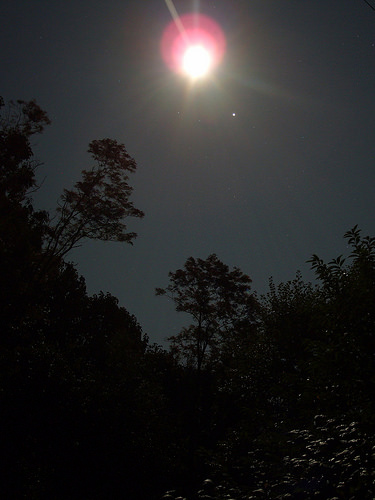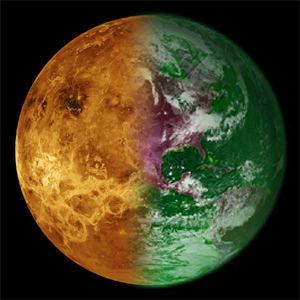Are you interested in knowing what planets are visible tonight? Almost every night of the year, some planet in our solar system can be spotted using either just your eyes, a pair of binoculars or a small telescope. Finding the planets is easy – but you just have to know how! Here’s a few simple lessons and some great links to helping you locate what planets you can see from your location on any given night…
Finding The Ecliptic Plane
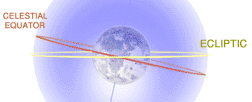 Just as the Earth orbits the Sun, our Moon orbits the Earth in a clockwork fashion, along an imaginary path called the ecliptic plane. Why is knowing the sky position of the Moon and Sun important? Because the planets also orbit the Sun like clockwork on the same path – the ecliptic plane. Picture our solar system from above. In the center is our Sun and around it the planets move along their own race tracks. The planets close to the Sun orbit faster and their track is smaller, while outer planets move slower and their track is longer – this is Kepler’s law in action!
Just as the Earth orbits the Sun, our Moon orbits the Earth in a clockwork fashion, along an imaginary path called the ecliptic plane. Why is knowing the sky position of the Moon and Sun important? Because the planets also orbit the Sun like clockwork on the same path – the ecliptic plane. Picture our solar system from above. In the center is our Sun and around it the planets move along their own race tracks. The planets close to the Sun orbit faster and their track is smaller, while outer planets move slower and their track is longer – this is Kepler’s law in action!
 Venus and Mercury speed past Earth’s position several times a year, passing in front of or behind the Sun. Earth is running with them, but on a longer track. On the outside tracks are Mars, the asteroid belt, Jupiter, Saturn, Uranus, Neptune and planetoid Pluto – all on the same flat plane. There are times when the Sun is positioned between Earth and the outer planets. They are still holding their position on their tracks, but we simply cannot see them. When the inner planets pass the Earth, or the Earth passes the outer planets, something very extraordinary happens – retrograde motion. How does it work? Picture yourself in a moving car coming up on another vehicle. As you approach, the other car seems to slow down, stand still and then move backwards. It’s a rather simple explanation, but it’s how retrograde motion works!
Venus and Mercury speed past Earth’s position several times a year, passing in front of or behind the Sun. Earth is running with them, but on a longer track. On the outside tracks are Mars, the asteroid belt, Jupiter, Saturn, Uranus, Neptune and planetoid Pluto – all on the same flat plane. There are times when the Sun is positioned between Earth and the outer planets. They are still holding their position on their tracks, but we simply cannot see them. When the inner planets pass the Earth, or the Earth passes the outer planets, something very extraordinary happens – retrograde motion. How does it work? Picture yourself in a moving car coming up on another vehicle. As you approach, the other car seems to slow down, stand still and then move backwards. It’s a rather simple explanation, but it’s how retrograde motion works!
Observing the Planets
 The two inner planets – Mercury and Venus – are closer to the Sun than Earth. This means we will always see them just before the Sun rises, or just after the Sun sets. The ring of the inner planet’s orbit is much smaller than Earth’s, and they will only appear a short distance above the horizon. At times, when Mercury reaches its greatest elongation, it is bright enough to be seen easily with just your eyes, but it helps to use binoculars. And we all know that Venus outshines every star in the sky! Mercury apparitions usually happen in the evening sky three times a year and three times in the morning. Usually, the best time to see Mercury is just after sunset near the vernal equinox. Since it orbits the Sun in just 88 days, it moves fast, so don’t delay your observations! If you observe Mercury through a telescope, you’ll see it enter a slim crescent phase as it passes between us and the Sun – just like our Moon! Another planet that goes through phases is inner Venus. Orbiting the Sun more slowly along its longer track every 244 days, we see Venus for months at a time instead of just days. It will appear in the evening for about six weeks as it comes out from behind the Sun, growing higher and brighter each night until it reaches a point between the Earth and Sun. This is when you’ll see a crescent phase in the telescope! Venus will then disappear and a week or two later it will return just before the Sun rises. It will stay in the morning sky for about 9 months until it once again switches its course back to the evening.
The two inner planets – Mercury and Venus – are closer to the Sun than Earth. This means we will always see them just before the Sun rises, or just after the Sun sets. The ring of the inner planet’s orbit is much smaller than Earth’s, and they will only appear a short distance above the horizon. At times, when Mercury reaches its greatest elongation, it is bright enough to be seen easily with just your eyes, but it helps to use binoculars. And we all know that Venus outshines every star in the sky! Mercury apparitions usually happen in the evening sky three times a year and three times in the morning. Usually, the best time to see Mercury is just after sunset near the vernal equinox. Since it orbits the Sun in just 88 days, it moves fast, so don’t delay your observations! If you observe Mercury through a telescope, you’ll see it enter a slim crescent phase as it passes between us and the Sun – just like our Moon! Another planet that goes through phases is inner Venus. Orbiting the Sun more slowly along its longer track every 244 days, we see Venus for months at a time instead of just days. It will appear in the evening for about six weeks as it comes out from behind the Sun, growing higher and brighter each night until it reaches a point between the Earth and Sun. This is when you’ll see a crescent phase in the telescope! Venus will then disappear and a week or two later it will return just before the Sun rises. It will stay in the morning sky for about 9 months until it once again switches its course back to the evening.
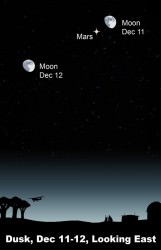 As we move outward along the ecliptic plane, we pass Earth and move on to Mars. Since its orbital track around the Sun is slightly longer than ours, there will be extended periods of time when Mars is visible. Do you remember retrograde motion? When the Earth catches up with Mars it will appear to slow down on its path across the sky as we approach it, stand still as we come alongside, and move the other way as we pass it. A Mars’ viewing year will begin when it first makes its appearance in the morning on the opposite side of our solar system. There it will stay until Earth’s orbit begins to catch up with it and it rises 6 minutes earlier each day. As the cycle continues, it won’t be long until Mars reaches opposition, meaning it (or any outer planet) rises precisely the same time as the Sun sets. As we pass, it becomes brighter and larger – but never the same size as our Moon.
As we move outward along the ecliptic plane, we pass Earth and move on to Mars. Since its orbital track around the Sun is slightly longer than ours, there will be extended periods of time when Mars is visible. Do you remember retrograde motion? When the Earth catches up with Mars it will appear to slow down on its path across the sky as we approach it, stand still as we come alongside, and move the other way as we pass it. A Mars’ viewing year will begin when it first makes its appearance in the morning on the opposite side of our solar system. There it will stay until Earth’s orbit begins to catch up with it and it rises 6 minutes earlier each day. As the cycle continues, it won’t be long until Mars reaches opposition, meaning it (or any outer planet) rises precisely the same time as the Sun sets. As we pass, it becomes brighter and larger – but never the same size as our Moon.
 Next up is Jupiter – orbiting the Sun once every twelve years. Jupiter is visible most of the year, beginning in the morning until sidereal time carries it to the early evening hours. With a much slower orbit of 30 years, graceful old Saturn will be viewable much of the year as well – waltzing slowly along the ecliptic plane. Far away Uranus and Neptune and planetoid Pluto can viewed whenever their respective constellations are visible. Retrograde motion also happens with the outer planets, but the process is much slower. Just remember… the planets all follow the same rule – the ecliptic plane. Do you remember what else also follows that same rule? That’s right… the constellations of the zodiac. You will always see the planets in relationship with those twelve constellations!
Next up is Jupiter – orbiting the Sun once every twelve years. Jupiter is visible most of the year, beginning in the morning until sidereal time carries it to the early evening hours. With a much slower orbit of 30 years, graceful old Saturn will be viewable much of the year as well – waltzing slowly along the ecliptic plane. Far away Uranus and Neptune and planetoid Pluto can viewed whenever their respective constellations are visible. Retrograde motion also happens with the outer planets, but the process is much slower. Just remember… the planets all follow the same rule – the ecliptic plane. Do you remember what else also follows that same rule? That’s right… the constellations of the zodiac. You will always see the planets in relationship with those twelve constellations!
What Planets Are Visible Tonight?
 We can observe the planets with our eyes, binoculars, or a telescope and many planets are viewable during many different times of the year. There are many on-line resources that can tell you when and where they will appear, as well as many periodicals which chart the planets’ paths. Would you like some resources to help you along your planetary discovery path? Then here are a few of my favorites:
We can observe the planets with our eyes, binoculars, or a telescope and many planets are viewable during many different times of the year. There are many on-line resources that can tell you when and where they will appear, as well as many periodicals which chart the planets’ paths. Would you like some resources to help you along your planetary discovery path? Then here are a few of my favorites:
See The Planets Tonight!
 It is very easy, even from light polluted areas, to follow Mercury, Venus, Mars, Jupiter and Saturn with just your eyes alone. When they are visible, they shine brightly enough to follow their movements without any special equipment. The outer planets are naturally dimmer because they are much further away. With a pair of binoculars as an aid, it’s also easy to see Uranus and Neptune, but they aren’t very big or very bright. Planetoid Pluto is so incredibly small and distant that it takes at least a medium-sized telescope and careful work over many nights with a star chart to identify properly. Now… Get out there and get started! Once you have gained confidence in the position of the ecliptic, it won’t be difficult to watch the action of the planets from night to night. They are easy to recognize and it won’t be long before you’ll be identifying them – not by luck – but as an amateur astronomer!
It is very easy, even from light polluted areas, to follow Mercury, Venus, Mars, Jupiter and Saturn with just your eyes alone. When they are visible, they shine brightly enough to follow their movements without any special equipment. The outer planets are naturally dimmer because they are much further away. With a pair of binoculars as an aid, it’s also easy to see Uranus and Neptune, but they aren’t very big or very bright. Planetoid Pluto is so incredibly small and distant that it takes at least a medium-sized telescope and careful work over many nights with a star chart to identify properly. Now… Get out there and get started! Once you have gained confidence in the position of the ecliptic, it won’t be difficult to watch the action of the planets from night to night. They are easy to recognize and it won’t be long before you’ll be identifying them – not by luck – but as an amateur astronomer!
“Planetary Line-Up” photo courtesy of Dennis Mammana (APOD).

